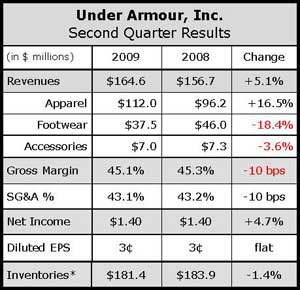Under Armour, Inc. beat street expectations for the second quarter and provided full-year guidance that exceeds the estimates of analysts, but acknowledgement that the business growth will slow in the second half and moves to increase reserves to sell off excess inventories quickly diminished the initial excited reactions to the companys report. UA shares ended the week down a bit to close at $24.29 on Friday.
The issue appears to be the lack of energy around UA footwear in the market and the companys failure to deliver on all the hype around the running shoe launch. This may have pumped too many pairs into the market to get the turns to be deemed successful and management certainly should not have characterized the entry into the running market as a “launch,” but the real fear may be the extent to which the footwear business will be a drag on earnings over the balance of the year.

The earnings outlook for the year would give the company a price to earnings multiple of 33.6, according to analyst estimates, which would be fine if UA was delivering on its revenue and earnings growth plans of 20% and 25%, respectively — but it is not. Considering that NKE shares have a current multiple of less than 19 and VF Corp. is under 14, the market may start to look at Under Armour as less of a growth story until it gets its footwear act together.
Management touted double-digit growth in each of its apparel segments with mens womens and youth all showing gains, but was less forthcoming on how the overall 16.5% growth for apparel was achieved. The footwear business fell 18.5% for the quarter as deliveries of running and training footwear failed to anniversary the much-hyped training launch in the prior years quarter. Apparel revenues were $112.0 million for the quarter and footwear revenues were $37.5 million for the period.
Going forward, company President David McCreight said they will “further dial in” the price value offering to the consumer, with improved sourcing, product and material engineering all seen as parts of the equation. There was also acknowledgement that they came away from the first six months of the running footwear experience feeling they were priced above the market by about $10. UA will also offer more price/value in core apparel basics this fall.
The International business, which made up less than 10% of the business in the year-ago quarter, was up 51% for the 2009 second quarter, driving some of the increase in the apparel business. The other driver was the direct-to-consumer business, which was up 36.6% for the quarter to approximately 16% of total revenues versus just 13% in the prior-year period.
UA had 28 outlet stores at the end of the quarter and four specialty stores. Management said they backed off plans for specialty stores in favor of investments in the outlet base and e-commerce. Outlet stores are expected to reach 35 doors by year-end.
Despite the increase in the direct-to-consumer business and the decrease in footwear, gross margins contracted about 10 basis points for the quarter to 45.1% of sales. Improved apparel sourcing provided a benefit of approximately 60 basis points for the period. Liquidation of apparel and increased reserves for footwear allowances and returns in Q2 product offset the benefits of the sourcing improvement and direct-to-consumer upside.
The move to liquidate inventories certainly helped the balance sheet. Cash and cash equivalents at quarter-end jumped nearly 600% to $79.5 million from just $13.3 million at quarter-end last year and the company had no borrowings outstanding under its $200 million revolving credit facility at the end of the period. Inventories were down 1.4% despite the heavy influx of footwear into the system in the first half.
Management credited a “strong performance” by the companys collections team, the higher mix of direct-to-consumer sales, and a year-over-year increase in the allowance for doubtful accounts for a 16.8% year-on-year decrease in the accounts receivable line at quarter-end.
SG&A came in at 43.0% of sales, down 20 basis points from the year-ago period. Marketing expense was 12.9% of revenues versus 14.4% in the prior year's period.
Looking ahead, UA anticipates full year net revenues of approximately $810 million and diluted EPS in the range of 80 to 82 cents per share for the year. Selling, general and administrative expenses for 2009 are still expected to grow in the low-teens on a percentage basis year-over-year. In 2008, UA earned 79 cents a share on sales of $804.9 million.














